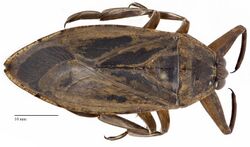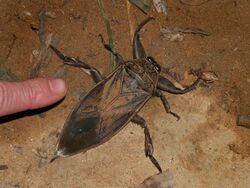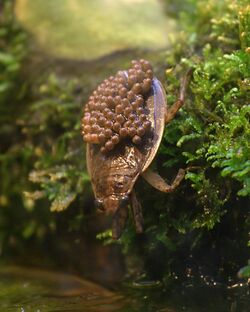Biology:Belostomatidae
| Belostomatidae | |
|---|---|

| |
| Lethocerus americanus | |
| Scientific classification | |
| Domain: | Eukaryota |
| Kingdom: | Animalia |
| Phylum: | Arthropoda |
| Class: | Insecta |
| Order: | Hemiptera |
| Suborder: | Heteroptera |
| Infraorder: | Nepomorpha |
| Family: | Belostomatidae Leach, 1815 |
Belostomatidae is a family of freshwater hemipteran insects known as giant water bugs or colloquially as toe-biters, Indian toe-biters, electric-light bugs, alligator ticks, or alligator fleas (in Florida). They are the largest insects in the order Hemiptera.[1] There are about 170 species found in freshwater habitats worldwide, with more than 110 in the Neotropics, more than 20 in Africa, almost as many in the Nearctic, and far fewer elsewhere.[2] These predators are typically encountered in freshwater ponds, marshes and slow-flowing streams. Most species are at least 2 cm (0.8 in) long, although smaller species, down to 0.9 cm (0.35 in), also exist. The largest are members of the genus Lethocerus, which can exceed 12 cm (4.5 in) and nearly reach the length of some of the largest beetles in the world.[1][3][4] Giant water bugs are a popular food in parts of Asia.[5]
Morphology

Belostomatids have a flattened, obovoid to ovoid-elongate body, and usually the legs are flattened.[4] The head features two large compound eyes, but lacks ocelli, contrasting with many hemipterans. Short antennae are tucked in grooves behind the eyes. A short breathing tube can be retracted into its abdomen.[6] Adults cannot breathe under water, so must periodically place the breathing tube at the surface for air (similar to a snorkel).[7]
Their hind tarsi have two apical claws. The frontal legs are modified into raptorial appendages that they use to grab their prey, except in the African Limnogeton, which has "normal" forelegs and is a specialized snail-eater.[4] Once caught, the prey are stabbed with their proboscis and a powerful proteolytic[8] saliva is injected, allowing the Belostomatid to suck out the liquefied remains.[3] Wing pads can be seen from the dorsal view. While the members of the subfamily Lethocerinae can disperse by flying,[1] other species, including Abedus herberti, have a greatly reduced flight apparatus and are flightless.[2][9]
Subfamilies and genera
BioLib lists three extant subfamilies and a number of fossil taxa:
Belostomatinae
Auth. Leach, 1815
- Abedus Stål, 1862
- Appasus Amyot & Serville, 1843
- Belostoma Latreille, 1807
- Diplonychus Laporte de Castelnau, 1833 (synonym Sphaerodema Laporte, 1833)
- Hydrocyrius Spinola, 1850 (synonym Poissonia Brown, 1948)
- Limnogeton Mayr, 1853
- Weberiella De Carlo, 1966
- Fossil genera
Horvathiniinae
Auth. Lauck & Menke, 1961; South America
- Horvathinia Montandon, 1911
Lethocerinae
Auth. Lauck & Menke, 1961
- Benacus Stål, 1861
- Kirkaldyia Montandon, 1909
- Lethocerus Mayr, 1853
Fossil taxa
subfamily Stygeonepinae Popov, 1971 †
- Aenictobelostoma Polhemus, 2000 †
- Belostomates Schöberlin, 1888 †
- Lethopterus Popov, 1989 †
- Manocerus Zhang, 1989 †
- Scarabaeides Germar, 1839 †
- Triassonepa Criscione & Grimaldi, 2017 †
Habits
Feeding and defense
Belostomatids are aggressive predators that stalk, capture, and feed on fish, amphibians, as well as aquatic invertebrates such as snails and crustaceans. The largest species have also been found to capture and feed on baby turtles and water snakes.[10] They often lie motionless at the bottom of a body of water, attached to various objects, where they wait for prey to come near. They then strike, injecting a venomous digestive saliva with their rostrum. Although their bite is excruciatingly painful, it is of no medical significance.[7] Occasionally, when encountered by a larger animal or a human, they have been known to "play dead" and most species can emit a fluid from their anus.[4][7] Due to this, they are assumed dead by humans only to later "come alive" with painful results.[7]
Breeding
Belostomatids show paternal care and these aspects have been studied extensively, among others involving the North American Belostoma flumineum and the East Asian Lethocerus (Kirkaldyia) deyrollei. In species of the subfamily Belostomatinae, the eggs are typically laid on the male's wings and carried until they hatch. The male cannot mate during this period. The males invest considerable time and energy in reproduction and females take the role of actively finding males to mate. This role reversal matches the predictions of R. L. Trivers' parental investment theory. In the subfamily Lethocerinae, the eggs are laid on emergent vegetation and guarded by the male.[11]
In Asian cuisine
Belostomatids can be found for sale in markets mainly in South and Southeast Asia involving the species Lethocerus indicus.[5] In South and Southeast Asia they are often collected for this purpose using large floating traps on ponds, set with black lights to attract the bugs. Adults fly at night, like many aquatic insects, and are attracted to lights during the breeding season.
References
- ↑ 1.0 1.1 1.2 P. J. Perez-Goodwyn (2006). "Taxonomic revision of the subfamily Lethocerinae Lauck & Menke (Heteroptera: Belostomatidae)". Stuttgarter Beiträge zur Naturkunde. Serie A (Biologie) 695: 1–71.
- ↑ 2.0 2.1 Thorp and Covich's Freshwater Invertebrates: Ecology and General Biology. 1 (4 ed.). Elsevier. 2015. pp. 954–955. ISBN 978-0-12-385026-3.
- ↑ 3.0 3.1 Haddad, V.; Schwartz, E.F.; Schwartz, C.A.; Carvalho, C.N. (2010). "Bites caused by giant water bugs belonging to Belostomatidae family (Hemiptera, Heteroptera) in humans: A report of seven cases". Wilderness & Environmental Medicine 21 (2): 130–133. doi:10.1016/j.wem.2010.01.002. PMID 20591375.
- ↑ 4.0 4.1 4.2 4.3 4.4 Randall T. Schuh; James Alexander Slater (1996). True Bugs of the World (Hemiptera:Heteroptera): Classification and Natural History (2 ed.). Cornell University Press. pp. 111–114. ISBN 978-0801420665.
- ↑ 5.0 5.1 Mitsuhashi, J. (2017). Edible Insects of the World. CRC Press. ISBN 978-1-4987-5657-0.
- ↑ Merritt, R.W. (2008). An Introduction to the Aquatic Insects of North America. Dubuque, Iowa: Kendall/Hunt Company.
- ↑ 7.0 7.1 7.2 7.3 A. C. Huntley (1998). "Lethocerus americanus, the "toe biter"". Dermatology Online Journal 4 (2): 6. PMID 10328676. http://escholarship.org/uc/item/4cb2q8wg/letho.html.
- ↑ Swart, C. C.; Deaton, L. E.; Felgenhauer, B. E. (2006). "The salivary gland and salivary enzymes of the giant waterbugs (Heteroptera; Belostomatidae)". Comparative Biochemistry and Physiology. Part A, Molecular & Integrative Physiology 145 (1): 114–122. doi:10.1016/j.cbpa.2006.05.010. PMID 16844394. https://pubmed.ncbi.nlm.nih.gov/16844394/.
- ↑ Phillipsen. I.C.; Kirk, E.H.; Bogan, M.T.; Mims, M.C.; Olden, J.D.; Lytle, D.A. (2015). "Dispersal ability and habitat requirements determine landscape-level genetic patterns in desert aquatic insects". Molecular Ecology 24 (1): 54–69. doi:10.1111/mec.13003. PMID 25402260.
- ↑ "BBC Nature - Giant water bug photographed devouring baby turtle". BBC Nature. https://www.bbc.co.uk/nature/13500857.
- ↑ Robert L. Smith (1997). "Evolution of paternal care in the giant water bugs (Hemiptera: Belostomatidae)". in Jae C. Choe. The Evolution of Social Behavior in Insects and Arachnids Sociality. Cambridge University Press. pp. 116–149. doi:10.1017/CBO9780511721953.007. ISBN 978-0-511-72195-3. https://archive.org/details/evolutionsocialb00choe.
Further reading
- D. R. Lauck (1962). "A monograph of the genus Belostoma (Hemiptera), Part I. Introduction and B. Dentatum and Subspinosum groups". Bulletin of the Chicago Academy of Sciences 11 (3): 34–81.
- D. R. Lauck (1963). "A monograph of the genus Belostoma (Hemiptera), Part II. B. Aurivillianum, Testaceopallidium, Dilatatum, and Discretum groups". Bulletin of the Chicago Academy of Sciences 11 (4): 82–101.
- D. R. Lauck (1964). "A monograph of the genus Belostoma (Hemiptera, Part III. B. Triangulum, Bergi, Minor, Bifoveolatum, and Flumineum groups". Bulletin of the Chicago Academy of Sciences 11 (5): 102–154.
- A. S. Menke (1960). "A taxonomic study of the genus Abedus Stål (Hemiptera, Belostomatidae)". University of California Publications in Entomology 16 (8): 393–440. https://archive.org/details/a-taxonomic-study-of-the-combined.
- R. L. Smith (1974). "Life history of Abedus herberti in Central Arizona". Psyche: A Journal of Entomology 81 (2): 272–283. doi:10.1155/1974/83959. http://psyche.entclub.org/pdf/81/81-272.pdf.
External links
- Factsheet from zoo.org
- Sex role reversal
- Toebiters
- Pictures of a Giant Water bug from whatsthatbug.com
- Lethocerus, Abedus, Belostoma spp. on the University of Florida / Institute of Food and Agricultural Sciences Featured Creatures Web site
- Giant Water Bug Feeding on Frog
Wikidata ☰ Q8356884 entry
 |




